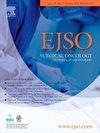颈动脉体肿瘤切除术后脑高灌注综合征样症状的发生率及危险因素
IF 3.5
2区 医学
Q2 ONCOLOGY
引用次数: 0
摘要
脑高灌注综合征(CHS)是颈动脉相关疾病手术后罕见但严重的并发症(发病率范围为0 - 25.7%),其与颈动脉体肿瘤(CBT)手术的关系尚不清楚。本研究旨在探讨cbt切除术后chs样症状的发生率及危险因素。方法回顾性研究2013年3月至2021年12月在北京协和医院行CBT手术的152例患者(165例手术肿瘤),临床记录完整。手术由血管外科的几个手术团队(研究期间约4-5个团队)进行,团队负责人均为资深血管外科医生,具有丰富的CBT手术经验。根据临床表现确定chs样症状,通过单因素和多因素回归分析确定其危险因素。结果该队列患者平均年龄为44.2±10.9岁,女性占67.1%(102/152)。13例(13/152,10.5%)接受双侧CBT切除术,共产生165个手术肿瘤。肿瘤中位最大直径为3.5 cm (IQR: 2.5 ~ 4.8 cm),其中Shamblin I、II、III型病灶37例(22.4%)、40例(24.2%)、88例(53.3%)。所有cbt均在全身麻醉下完全切除,51例患者术前接受球囊闭塞试验(51/152,33.6%),术前未进行栓塞。术中行颈内动脉介入治疗34例(34/165,20.6%),行颈外动脉结扎43例(43/165,26.1%)。165例手术中,43例术后出现chs样症状(26.1%,43/165),其中26例因症状严重而接受脱水治疗(60.5%,26/43),多数在术后48 h内出现症状(90.7%,39/43)。单因素分析显示,冠心病样症状的发生与术后即时心率(HR)升高(P = 0.006)、术后第1天早晨心率(P = 0.004)、ICA干预(P = 0.002)和术后新发高血压(P = 0.02)显著相关。此外,多因素回归分析显示,ICA干预(P = 0.008)和新发高血压(P = 0.017)仍然是发生冠心病样症状的独立危险因素。结论cbt切除与术后chs样症状发生率显著相关,其中术中ICA干预和术后新发高血压是独立危险因素,应给予重视和密切监测,防止危及生命的chs相关脑并发症的发生。本文章由计算机程序翻译,如有差异,请以英文原文为准。
Incidence and risk factors of cerebral hyper-perfusion syndrome like symptoms after resection of carotid body tumours
Introduction
Cerebral hyper-perfusion syndrome (CHS) is a rare but severe complication after surgery of carotid artery related disease (with a varied incidence range of 0–25.7 %), while its association with carotid body tumour (CBT) surgery is unknown. This study aimed to investigate the incidence and risk factors of CHS-like symptoms after resection of CBTs.
Methods
This retrospective study included 152 CBT patients (165 operated tumours) who received surgery at Peking Union Medical College Hospital from March 2013 to December 2021 and had fully-available clinical records. Surgeries were performed by the several operation teams (around 4–5 teams during the study period) from the department of vascular surgery, of which the team leaders were all senior vascular surgeons who had full experience on CBT surgery. CHS-like symptom was determined based on clinical manifestation and its risk factors were identified by univariate and multivariate regression analyses.
Results
The mean age of this cohort was 44.2 ± 10.9 years and female patients represented 67.1 % (102/152). There were 13 (13/152, 10.5 %) cases receiving bilateral CBT resections, generating a total of 165 operated tumours. The median maximum diameter of the tumours was 3.5 cm (IQR: 2.5–4.8 cm), with 37 (22.4 %), 40 (24.2 %) and 88 (53.3 %) lesions being classified as Shamblin I, II and III, respectively. All CBTs were completely resected under general anaesthesia, with 51 patients undergoing balloon occlusion tests (51/152, 33.6 %) preoperatively and no preoperative embolization was performed. During surgery, 34 cases (34/165, 20.6 %) underwent intervention for internal carotid artery (ICA) and 43 cases (43/165, 26.1 %) underwent external carotid artery ligation. Among the 165 operations, 43 cases developed CHS-like symptoms after surgery (26.1 %, 43/165), of which 26 cases received dehydrant therapy due to severe symptoms (60.5 %, 26/43) and most cases developed symptoms within 48 h after surgery (90.7 %,39/43). Univariate analysis revealed that occurrence of CHS-like symptoms is significantly related with elevated post-operation immediate heart rate (HR) (P = 0.006), post-operation day 1 morning HR (P = 0.004), ICA intervention (P = 0.002) and postoperative new-onset hypertension (P = 0.02). Furthermore, ICA intervention (P = 0.008) and new-onset hypertension (P = 0.017) remained the independent risk factors for development of CHS-like symptoms in multivariate regression analysis.
Conclusion
CBT excision is related to a significant incidence of postoperative CHS-like symptoms, of which intraoperative ICA intervention and post-operative new-onset hypertension are the independent risk factors, thus more attention and closer monitoring should be given on such patients so as to prevent life-threatening CHS-related cerebral complications.
求助全文
通过发布文献求助,成功后即可免费获取论文全文。
去求助
来源期刊

Ejso
医学-外科
CiteScore
6.40
自引率
2.60%
发文量
1148
审稿时长
41 days
期刊介绍:
JSO - European Journal of Surgical Oncology ("the Journal of Cancer Surgery") is the Official Journal of the European Society of Surgical Oncology and BASO ~ the Association for Cancer Surgery.
The EJSO aims to advance surgical oncology research and practice through the publication of original research articles, review articles, editorials, debates and correspondence.
 求助内容:
求助内容: 应助结果提醒方式:
应助结果提醒方式:


